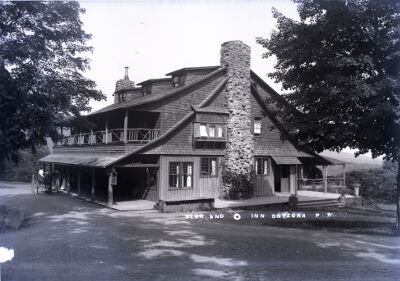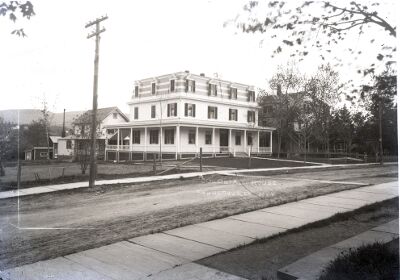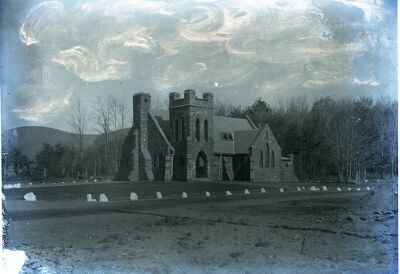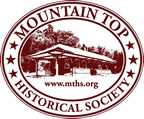Mountain House Walking Stick
These two photos show a new and exciting accession to MTHS's archive. More details on this walking stick which joins the earlier donation of a walking stick from the Hotel Kaaterskill and what we are planning to honor the gift will follow.


Wiltse-Dunn collection slides
We are happy to announce that The Mountain Top Historical Society has received a generous donation of 42 glass plate negatives from Shirley and Gerald Dunn. The photographs were taken in the early 20th Century by Oscar Showers and include photographs taken in and around Tannersville. They include some images of general interest and several family photographs of the Showers family and others as well as local homes and buildings. The photographs have been scanned and digitized and are being made available for viewing. Call ahead to arrange to see them at the Society's Visitors' Center. Here are nine of the photos (two versions of the Star Rock photo).
Leah Wiltse - Shirley Dunn Collection
We are happy to announce that The Mountain Top Historical Society has received a generous donation of 42 glass plate negatives from Shirley and Gerald Dunn. The photographs were taken in the early 20th Century by Oscar Showers and include photographs taken in and around Tannersville. They include some images of general interest and several family photographs of the Showers family and others as well as local homes and buildings. The photographs have been scanned and digitized and are being made available for viewing. Call ahead to arrange to see them at the Society's Visitors' Center. More will be posted here and on our Facebook page soon. Among the images is this one of Howard's Souvenirs. The site was later occupied by the A & P and now by the Bear Plaza. To see this image in a somewhat larger size, right click and view image.
The photographs were taken in the early 20th Century by Oscar Showers and include photographs taken in and around Tannersville. They include some images of general interest and several family photographs of the Showers family and others as well as local homes and buildings. The photographs have been scanned and digitized and are being made available for viewing. Call ahead to arrange to see them at the Society's Visitors' Center. More will be posted here and on our Facebook page soon. Among the images is this one of Howard's Souvenirs. The site was later occupied by the A & P and now by the Bear Plaza. To see this image in a somewhat larger size, right click and view image.
On another note, our friends at Historic Automobile Endurance Runs identify the car in the photo as a 1903 Locomobile steam car.
More detail from a reply to a post of this picture on the Facebook page of the Horseless Carriage Club of America. A post there by Pat Farrell says "This is definitely a 1903 Locomobile Model B long wheel base Runabout steam car. Page 51 of "The Genealogy of the Locomobile" by Don Ball has a picture of this same model."
We're always amazed by the expertise of automobile and railroad enthusiasts. Thanks.
Toppesfield
Deer Mountain Inn was, in the mid 1900s, known as Toppesfield Manor. A folded rack card/brochure from that period is shown here. We've unfolded it and combined the front and back sides in a single image with a background color taken from the card. Right click on the image and select 'view image' to see it in a more readable size.

William Young
William Young - Mountain Top Soldier
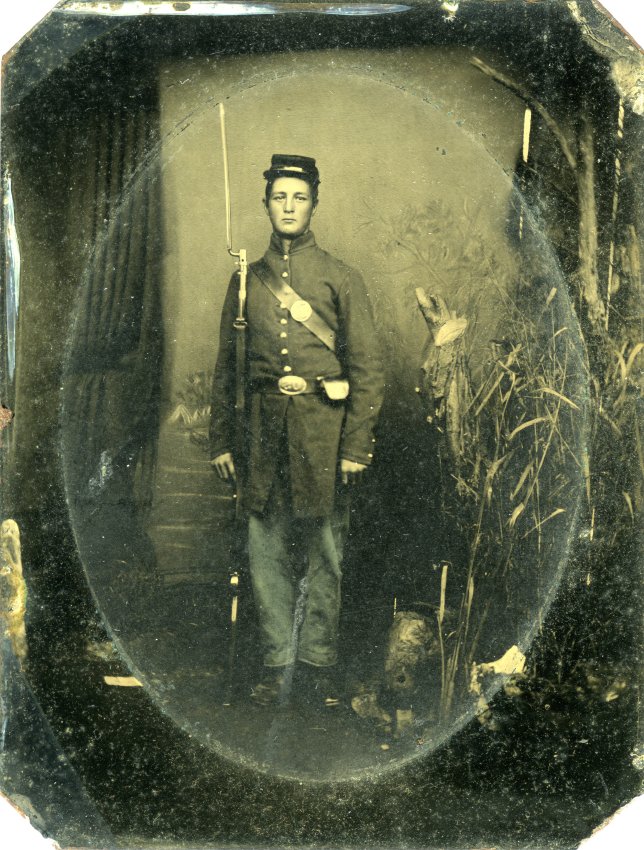 Generations of the Young Family of Platte Clove owned land at the top of Platte Clove. Initially farmers they, like other enterprising Mountain Top Families, found that the tourist industry could be more rewarding. They opened The Grand Canyon House, built stairways, bridges, and paths into the rugged Platte Clove, and established the area as a popular resort. The collection of family documents, papers related to The Grand Canyon House, and postcards from the hotel, donated by Odile Dwyer traces the history of their efforts. A significant part of the collection is the history of William Young, who at age 27 in December of 1863, left the Mountain Top to enlist in the United States Army. He was assigned to Company E of the 15th Regiment of the New York Engineers. William served for only seven months, most of it in a hospital in Washington DC as a result of a worsening illness. Nancy Allen relates William's story in the Spring 2017 issue of the Society's newsletter The Hemlock. The purpose of this article is to show some of the items related to William's Story. The images can be seen in larger format by right clicking and selecting view image.
Generations of the Young Family of Platte Clove owned land at the top of Platte Clove. Initially farmers they, like other enterprising Mountain Top Families, found that the tourist industry could be more rewarding. They opened The Grand Canyon House, built stairways, bridges, and paths into the rugged Platte Clove, and established the area as a popular resort. The collection of family documents, papers related to The Grand Canyon House, and postcards from the hotel, donated by Odile Dwyer traces the history of their efforts. A significant part of the collection is the history of William Young, who at age 27 in December of 1863, left the Mountain Top to enlist in the United States Army. He was assigned to Company E of the 15th Regiment of the New York Engineers. William served for only seven months, most of it in a hospital in Washington DC as a result of a worsening illness. Nancy Allen relates William's story in the Spring 2017 issue of the Society's newsletter The Hemlock. The purpose of this article is to show some of the items related to William's Story. The images can be seen in larger format by right clicking and selecting view image.
Thomas Nast's 'Sketches' Published 150 Years Ago.
One of the many Catskills prints from the 19th Century in our Justine Hommel Archive Room is Thomas Nast's classic 1866 print “Sketches Among the Catskill Mountains” which appeared in Harper's Weekly over a hundred fifty years ago in July 1866. Nast is considered the “Father of the American [political] Cartoon,” and for good reason. He introduced the elephant and the donkey to represent the Republican and Democratic parties, created a series of cartoons that helped bring down Boss Tweed and, in a lighter vein, created the image of Santa Claus that persists to this day. Nast's two page spread of twenty-eight illustrations appeared in Harper's July 21, 1866 issue but was conceived in the previous September during his two-week stay at the Catskill Mountain House. Five months before his stay, our country went through one of the most significant months in our history. In April 1865, the Civil War ended with Lee's surrender at Appomattox and President Lincoln was assassinated. The mix of grief, melancholy, and relief that Nast, his family, their servant, and other late summer guests at the Mountain House felt must have pervaded the mood at the Mountain House that September. [A desk register in the collection of the Vedder Library at the Greene County Historical Society shows the dates of his stay.] During the war, a large portion of the pages of Harper's Weekly covered its events. In these illustrations Nast captured scenes of a recovering America, at least scenes of a recovering upper-class America relaxing and playing in the idyllic Catskill Mountains.
Nast's two page spread of twenty-eight illustrations appeared in Harper's July 21, 1866 issue but was conceived in the previous September during his two-week stay at the Catskill Mountain House. Five months before his stay, our country went through one of the most significant months in our history. In April 1865, the Civil War ended with Lee's surrender at Appomattox and President Lincoln was assassinated. The mix of grief, melancholy, and relief that Nast, his family, their servant, and other late summer guests at the Mountain House felt must have pervaded the mood at the Mountain House that September. [A desk register in the collection of the Vedder Library at the Greene County Historical Society shows the dates of his stay.] During the war, a large portion of the pages of Harper's Weekly covered its events. In these illustrations Nast captured scenes of a recovering America, at least scenes of a recovering upper-class America relaxing and playing in the idyllic Catskill Mountains.
The Mountain House itself occupies the center of the print and is immediately surrounded by serious views of the mountains and waterfalls. A sketch of guests looking out from the Piazza at the expansive view of the Hudson Valley seems to me to have a pensive mood, reflecting the post war feelings of the guests. The other illustrations at the center of the piece accurately capture the mountain scenery.
It is in many of the smaller cartoons that border the print where Nast's humor comes through. A guest arrives with a massive trunk and later leaves passing the staff, his pockets empty—their hands outstretched for tips. Another guest tries to shake a chained bear off his leg, a mother reads her paper oblivious to her children running near the cliff, while a nanny tries to keep them under control. Budding artists are perched on every rock trying to capture their personal landscape masterpieces. A hiker is held back from the brink of a cliff by his fearful spouse, and after a long day, dreams of tumbling from a ladder to the top of yet another cliff.
The print is a masterpiece of Catskills illustration. We are fortunate that 'The Father of the American Cartoon' graced us with this view of his visit to our Catskill Mountains.
Historic Signature Quilts
Four Historic Quilts from the MTHS Archives were on display in the Summer of 2015 thanks to the cooperation of the Patchworkers and the gifts of the original donors. Each of the quilts, known as signature quilts, contain embroidered or cross-stitched signatures of Mountain Top residents from the 1800s, the early 1900s or the 1950s and '60s. Betty Verhoeven and other talented quilters of the Patchworkers have lent their expertise and skills to prepare the quilts for display -- first at their 42nd Patchworkers quilt show on August 1 and 2 at the Windham High School and again at the MTHS Local History Day on August 15 at the Society's Ulster and Delaware Train Station in Haines Falls.
contain embroidered or cross-stitched signatures of Mountain Top residents from the 1800s, the early 1900s or the 1950s and '60s. Betty Verhoeven and other talented quilters of the Patchworkers have lent their expertise and skills to prepare the quilts for display -- first at their 42nd Patchworkers quilt show on August 1 and 2 at the Windham High School and again at the MTHS Local History Day on August 15 at the Society's Ulster and Delaware Train Station in Haines Falls.
The quilt dated 1849 was a gift of Wilma Kohler of Hunter. The quilt from the 1950s was a gift of Fred Wilson. Mr Wilson's post about the quilt on the 23A + Facebook page inspired the effort to prepare these quilts for public display. The occasion of the 42nd Patchworkers Quilt Show, and MTHS's Local History Day with it's emphasis on Women on the Mountain Top seem the ideal opportunities to reintroduce these quilts to the community.
Page 1 of 2



